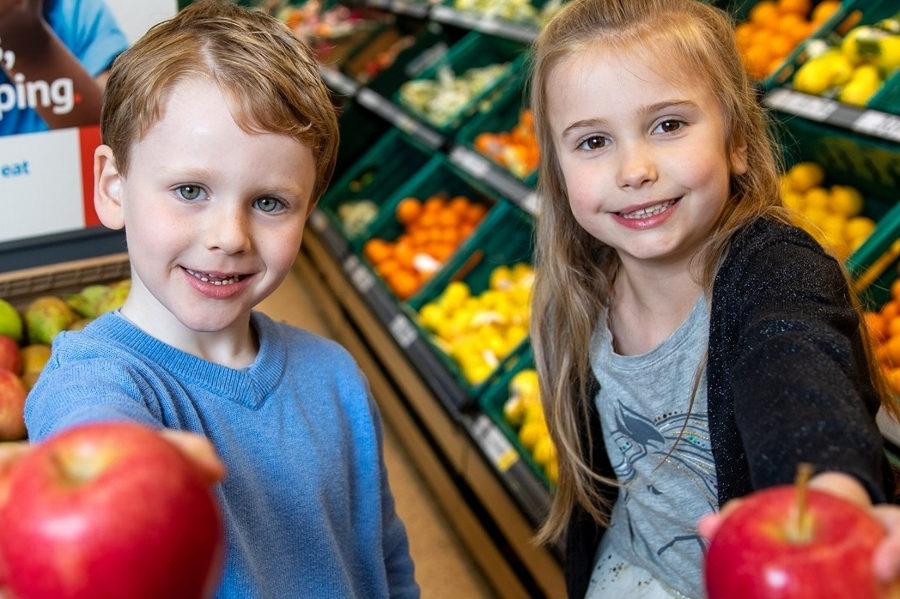Kids Free Fruit

Tesco stores have now given out more than 100 million pieces of fruit, as part of its ground-breaking Free Fruit for Kids scheme.
Parents can grab free fruit, including apples and pears from stands in the fruit and veg aisle for their children to snack on while they do their shopping.
Free Fruit for Kids is aimed at helping children get one of their five a day as well as helping to make the shopping journey a little easier for parents.
The scheme, which was the first of its kind by a leading retailer in the UK, launched in 800 stores in summer 2016. It was the brainchild of Maria Simpson, a Tesco checkout colleague from the Brigg superstore in Lincolnshire who suggested giving free fruit to parents for their children to eat during shopping trips as an alternative to sweets.
The Government recommends that children - like adults - eat at least five portions of fruit and vegetables every day. But research has shown that less than one in five (18 percent) manage five portions. [1]
Alessandra Bellini, Tesco's Chief Customer Officer, said:
"We're incredibly proud that kids across the UK have been able to enjoy 100 million pieces of fruit. We know that encouraging children to eat more fruit can sometimes be tricky and we hope that this helps children pick up healthy eating habits early."
Tesco's charity partners in Little Helps for healthier living, the British Heart Foundation, Cancer Research UK and Diabetes UK, commented:
"Fruit and veg are a key part of a healthy balanced diet, but we know many of us are not eating enough. Simple ideas like Tesco's Free Fruit for Kids is one way that could help parents encourage their children to eat more of their 5-a-day. That's why we're delighted to help Tesco celebrate giving away 100 million pieces of fruit; they should be rightly proud of this effort to help children across the UK eat more healthily."
Free Fruit for Kids is part of the supermarket's continued commitment to making it easier for customers and colleagues to live more healthily. It has already removed over 8,000 tonnes of sugar, fat and salt across a range of 2,000 products including breakfast cereals, yoghurts and ready meals through the ongoing reformulation of its own label products.
Healthier Tesco
In 2015, Tesco became the first major retailer to remove sweets and chocolates from checkouts across all store formats, including smaller convenience stores. Also in the same year, Tesco announced that all children's lunchbox-sized soft drinks it sells would have no added sugar
In January 2018, Tesco launched a new 5-year strategic health partnership with the British Heart Foundation, Cancer Research UK and Diabetes UK with the aim of helping Tesco colleagues, customers and their families to make sustainable lifestyle changes and adopt healthier habits
Tesco has to date run four in-store health events to encourage customers to discover and try healthier alternatives. In September 2018, as part of its customer health event, Tesco promoted products lower in salt, fat and sugar through its 'Helpful Little Swaps' basket, which cost 12% less than a regular basket and resulted in a 17% sales uplift on these products versus the previous year
In September 2018 Jamie Oliver joined forces with Tesco to help make healthier eating a little easier. He has created a series of healthier recipes and tips to help Tesco customers and colleagues cook health food from scratch
In 2019, Tesco became a supporter of 'Veg power', a new campaign that uses humour to get children excited about eating vegetables
Loose fruit is now part of Tesco's popular lunchtime meal deal and a third of its ready meals range contributes at least one of five a day portions of fruit and vegetables
Tesco has signed up to the Food Foundation's 'Peas Please Pledge', that brings together farmers, retailers, fast food and restaurant chains, caterers, processors and government departments with a common goal of making it easier for everyone to eat vegetables
Ref:
